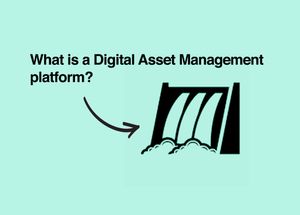What is a digital asset management platform?
Your marketing team has worked hard, you've developed some great creative digital assets, you launch, measure, and then move onto the next priority. But wait, hold on - where did those photoshop files go? Do we need to brief the agency or get new assets, why can't we use the ones from last year? What happened to that great image we used that one time? Do we still have the usage rights?
Sound familiar? Despite all the effort that goes into creating assets, most marketing teams fall short when organising their assets or automating their assets into multiple marketing channels.
What is a Digital Asset Management (DAM) platform?
Martech Playbooks defines a Digital Asset Management platform as:
Software that stores, organises, and distributes files in a central location.
These files can include images, creative working files, video, audio, presentations, documents, and more.
What is the difference between a DAM and a MRM (Marketing Resource Management) tool?
While DAMs focus on the storage of digital assets, Marketing Resource Management tools (MRM) focus on the management and approvals.
Both DAMs and MRMs can work as asset storage, however MRMs generally focus more on the review such as allowing for mark-ups, comments, feedback, and approval gateways. There are also solutions that combine both a DAM and MRM.
Use cases
Sharing and reusing assets - A DAM allows you to save and reuse assets from across your organisation. This includes sharing imagery, or even using a great existing PSD file and changing it. Simply by reusing your assets, you are saving potentially thousands of design hours.
Campaign roll outs - DAMs are advantageous for rolling out multiple versions of hero assets and can be the launch pad for all teams and integrated platforms to access the same assets without needing multiple emails and file transfers.
Master asset updates - When the DAM has assets integrated to marketing channels, the DAM can be updated opposed to requiring revising and uploading directly to channels. This saves a lot of time if you have the DAM correctly connected to multiple channels and you need to change the creative as you only need to do it once.
Agency and external access - If you have a creative agency partner or external design team the DAM can be the delivery portal to provide assets in a secure way without large file transfers.
Brand and marketing reviews - DAMs allow you to get a really clear view of the brand assets created and delivered, as well as when pulling together quarterly reviews of previous marketing activity.
Pros 👍
- Centralisation and visibility - Having a central location for ALL your assets is one of the main advantages of a DAM. Consider the time saved when your team members aren't spending time trying to source files which sometimes can take days or even weeks. Centralisation also improves visibility, as all teams can contribute to the asset library and see what's available.
- Brand governance - A DAM enables brand guardians to ensure that the assets being delivered over the organisation meet brand guidelines and usage requirements.
- Repurposing assets - Instead of creating new assets and sourcing new imagery, a DAM enables for easy reusability of files and templates.
- Tagging - Modern DAMs have sophisticated tagging abilities that allow you to tag the assets for sorting but also measurement of the asset's performance. Some DAMs have AI enabled to automate tagging across assets.
- Integration - DAMs can integrate 2 x ways: 1. Integrate with your creative development tools for seamless revision and updates, 2. Integrate with the marketing channels they are intended such as your email provider, social media manager or website.
- Collaboration - DAMs allow for multiple users, so that your marketing team can collaborate effectively internally and externally without having to transfer large assets to each other.
- Implementation - DAMs are relatively straight forward to implement, and the main challenge being sourcing all the imagery and assets. Integration of the DAM to your creative development tools and channels is usually very easy.
Cons 👎
- Ownership - As a DAM is a shared technology, determining its ownership, admins, and funding can be complicated. Depending on which team owns the DAM can have very different impacts on the quality, quantity and access of the assets. For example, if the DAM is owned by the creative team then only on-brand assets will likely exist in the DAM. However this itself can be restrictive on other teams who may wish to use non-branded assets and so forth. If the DAM is owned by marketing or operations, it may be less governed from a brand perspective.
- Enforcing process - Regardless of whether you have a simple folder system or a DAM, enforcing process for all users to upload and tag their assets requires a very stringent process and significant internal communications. It's simply not easy to ensure everyone uses the DAM. You can be sure that when everyone does, you may be surprised as what assets are actually being used in different parts of the business.
- Speed of platform - All vendors will claim fast speeds, however be sure to test this as part of the proof of concept. If it takes a long time to use the DAM, you can be guaranteed that your team won't use it. Speed for the end-user is a mandatory requirement for successful DAMs.
Vendors
Martech Playbooks provides education and is 100% vendor neutral. Here are some known vendors in the DAM space (some of these have MRM functions too):
- Adobe Experience Manager
- Airtable
- BrandWorkz
- Brandfolder
- Bynder
- Collaboro
- Canto
- Cloudinary
- Daminion
- Dash
- Filecamp
- Filerobot
- Fotoware
- Frontify
- ImageKit
- ImageRelay
- IntelligenceBank
- Kontainer
- Marcom Gather
- MediaBeacon
- MediaValet
- Mediafly Engagement360
- Monday
- OpenAsset
- Outfit
- PhotoShelter for Brands
- PickIt
- Pics.io
- Salsify
- Swivle
- Syndigo
- Vevva Vault PromoMats
- Widen Collective
Martech Playbooks verdict
A digital asset management platform makes 100% sense for marketing teams that need to organise their assets.
Make sure to get buy-in from all the teams using the DAM as you'll need clear ownership and process. DAMs do have risk of being shelfware if your teams go back to their default filing processes.
Ensuring your team want to use the DAM is also important, so the usability, speed and ease of access is also important. A good DAM should enable the end-user to upload assets very quickly without friction.
Integrating your DAM with other platforms is a smart way to manage your assets - both creation and delivery. When integrating the DAM into a marketing automation platform or CRM this empowers your marketers to create workflows with less production blockers.
Want a Martech Playbooks expert do a comprehensive audit of your situation? Contact us.


